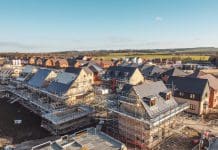Education construction output contracted significantly in 2018 after several years of growth. AMA Research’s new Education Construction Market Report examines the causes of the downward spiral and the outlook for this crucial sector
The Department for Education (DfE) is the single largest client for education construction works. Between 2013 and 2017, the education construction sector grew a substantial 46%. However, in 2018 output suddenly decreased by 8%. This significant decline can be associated with budget cuts.
The public sector (which includes the education sector) still accounts for the largest share of the education construction sector, accounting for 51% of the market in 2018. This is compared with a 78% share for public sector construction in 2010.
2018 saw a 7% downward movement for education projects reaching the detailed planning stage; consequentially, 2019 and 2020 are also showing lower activity. It may not all be doom and gloom. There is potential for growth from a number of different programmes within the public sector, for example the Priority Schools Building Programme (PSBP). However, individual funding for schools remains a constraint on future capital spending.
The downward trend
This is likely to be tempered by the level of renewal and refurbishment programmes being undertaken within the existing schools estate. These should provide a solid foundation for output growth into the medium-longer term.
£1.4bn of investment was allocated for schools in the public sector 2018-19 budget to improve and maintain the condition of their facilities, with a similar amount allocated for 2019-20. However, the condition of the school estate is expected to deteriorate despite this planned investment.
The editor of AMA Research’s Education Construction Market Report states: “The outlook for the construction sector remains difficult to predict given the instability in the political sphere and the continued uncertainty that this has created for not only the construction sector but also the wider UK economy.
“While the construction pipeline remains positive, continued caution within the market for some sectors persists.”
Education construction pipeline projects
As of June 2019, projects were expected to be focused in London, Scotland and the North West regions.
In London, state universities and colleges account for the largest share of contracts, holding a 33% share. The redevelopment of the Paul Marshall Building at Lincoln’s Inn is currently the largest subsector contract.
The building will house the Marshall Institute for Philanthropy & Social Entrepreneurship, along with the academic departments of accounting, finance and management, training facilities, sports and arts rehearsal facilities (including a Sports England-standard multipurpose sports hall, available for both staff and students). The scheme is due for completion in July 2021.
The second largest share of the pipeline in London projects for state secondary schools, which accounted for a further 28% of contracts (June 2019).
Development of Shoreditch Park Academy – a secondary free school with sixth form – will provide an additional 1,650 school places by 2021 along with a 9,200 sq m leisure centre containing swimming pool, sports hall, football pitches and tennis courts. This scheme is part of a wider mixed used community development scheme and was procured through the Southern Construction Framework.
In Scotland’s education pipeline, it is also state universities and colleges that account for the largest share at 54%, followed by state secondaries, at 27% (June 2019). This includes projects such as the Schools for the Future programme, with the aim of building and/or refurbishing over 117 schools by March 2020.
Don’t forget, however, that in November 2018 the Scottish Government assigned £1bn for school rebuilding and refurbishment from 2021, therefore there is still scope for growth in the near future.
It is worth noting that Scotland has one of the lowest proportions of independent schools after Wales, Northern Ireland and the North East, with just 3% of total private schools located in Scotland. As such, private and church schools’ work is expected to account for just 3% (£100m) of contracts in the pipeline.
The North West region has the highest proportion of university and college work in the UK. A number of universities in the region have significant pipelines of work, most notably the University of Manchester. Here a £1.5bn innovation district will be located on a 26-acre site in the heart of the city. Plans include a 3.5m sq ft mixed-use space including three acres of high-quality public realm.
Manchester Metropolitan University also has detailed planning for a £40m Arts & Media Building and a £45m Science & Engineering Building, as well as a programme of smaller value work.
State secondary schools have the second largest share of pipeline projects in the North West. There are currently 233 pipeline schemes within this subsector. One of the largest schemes is for a secondary school in Manchester, the school is to be known as the Matthew Morse High School, due to complete by February 2021.
Together these schemes offer great room for growth within the education construction sector. Unfortunately, however, the £1.4bn Free Schools Programme – which aimed to open 500 new schools by the end of 2020-21 – is behind schedule, with the majority of funding not expected to be used until some point in 2020.
There will be a negative impact
Tom Hall, chief economist at AMA Research, said: “The education construction sector will be negatively impacted by the Covid-19 pandemic over 2020 as construction sites close.
“There are some hopes that is likely to be less impacted compared to other sectors due to the nature of the construction work and with future government spending promises in the pipeline, over 2021 and onwards the future is looking positive.”
The information here was taken from the Education Construction Market Report published by AMA Research, which is available to purchase now at www.amaresearch.co.uk or by calling 01242 235724.
Forecasts of market developments are based on our expert interpretation of the wide range of factors influencing the market. AMA Research assesses the key positive and negative factors impacting on the market and then develops five-year forecasts of trends.
Lesley-May Baker
AMA Research
+44 (0)1242 235724
Lesley-MayBaker@amaresearch.co.uk














